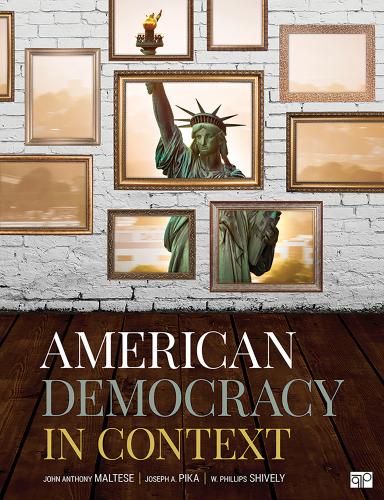8 Part IV Institutions of American DemocracyChapter 11: CongressPerspective: Can Legislatures Exercise Effective Control Over the use of Force?The Functions of CongressLegitimacy and RepresentationModels of RepresentationPork Barrel Projects and EarmarksDemographic RepresentationConstituency ServiceLawmakingExecutive OversightShaping Foreign PolicyConstitutional PowersNecessary and Proper ClauseImpeachmentAppointmentsThe Structure of CongressBicameralismDistinctive House and Senate RulesCongressional SessionsCommittees and SubcommitteesHow Congress OperatesInfluence in CongressRank-and-File MembersParty LeadersCommittee and Subcommittee ChairsCongressional StaffCongressional Support AgenciesPicture Yourself … Visiting the Parliament House in New Delhi, IndiaAssembling Coalitions Makes Action PossibleDecentralizing ForcesCentralizing ForcesFrom Czars to Committee Government to Party DictatorsPresidential Influence on Congressional CoalitionsThe Legislative ProcessThe Budget ProcessConsequences for DemocracyChapter 12: The PresidencyPerspective: Why Have the Norms for Presidential Communication Changed?Presidential and Parliamentary SystemsThe Evolving Job of PresidentConstitutional RolesCommander in Chief of the Armed ForcesChief DiplomatPicture Yourself … In Caracas, VenezuelaChief LegislatorChief AdministratorChief MagistrateExtra-Constitutional RolesChief BudgeterChief EconomistPolitical Leader and Head of StateTheories of Presidential PowerPublic Approval of PresidentsThe Institutional PresidencyThe Executive Office of the PresidentThe Vice PresidentThe CabinetPresidential Goals and Keys to SuccessPersonal AbilityLegislative StrategyAppealing to PartySetting the Legislative AgendaIssuing VetoesGoing PublicAdministrative StrategyRegulationsUnilateral Executive ActionsJudicial StrategyJudicial SelectionEnforcementConsequences for DemocracyChapter 13: BureaucracyPerspective: How do Governments Respond During Natural Disasters?Democracy and Bureaucracy in the United StatesFeatures of a Modern BureaucracyWeber’s Model of BureaucracyDistinctive Features of U.S. BureaucracyA Cultural Distrust of Government Power and CapacityLack of Constitutional StandingUncertain GuidanceNeutral Agents Are Forced to Be PoliticalExperimental StructuresThe Checkered History of Bureaucracy in the United StatesHamilton Versus JeffersonNineteenth-Century ChangesThe Creation of the U.S. Civil ServiceThe Complex Structure of the Federal BureaucracyDepartmentsIndependent AgenciesIndependent Regulatory CommissionsGovernment CorporationsHybrid OrganizationsThe Size of the Federal BureaucracyThe Search for ControlAnnual Budget ReviewsAuthorization of ProgramsOversight of Agency PerformanceNomination and Confirmation of Political AppointeesReorganization of the BureaucracyDramatic Reorganizations: The National Security ApparatusPicture Yourself … Advising the President on Policy Toward RussiaManaging Public EmployeesWhen Control Proves ElusiveConsequences for DemocracyChapter 14: The JudiciaryPerspective: When do Reactions to Unpopular Court Decisions Threaten Judicial Independence?An Independent Judiciary Enforcing the Rule of LawThe Creation of Judicial ReviewPrecedents for Judicial ReviewThe Framers’ IntentMarbury v. MadisonThe Context of Marbury v. MadisonThe Decision in Marbury v. MadisonJudicial Review of State ActionJudicial Review Around the WorldPicture Yourself … As A U.S. Marshal Charged With Protecting Federal JudgesAn Overview of the U.S. Court SystemThe Federal Court SystemU.S. District CourtsU.S. Courts of AppealsThe U.S. Supreme CourtState Court SystemsThe Supreme Court in ActionGetting to the CourtHow the Court Decides CasesThe Role of Judicial Philosophy in Decision MakingThe Jurisprudence of Original IntentJudicial Restraint Versus Judicial ActivismLimits on the Supreme CourtConstitutional ChecksNoncomplianceHow Judges Are SelectedThe Selection of Supreme Court JusticesChoosing Supreme Court NomineesConfirming Supreme Court NomineesThe Selection of Lower Federal Court JudgesSenatorial Courtesy Versus Presidential PrerogativeDiversifying the BenchJudicial Selection in the StatesConsequences for Democracy
9 Part V Public PolicyChapter 15: Domestic and Economic PolicyPerspective: What Can the United States Learn from Canada’s Legalization of Recreational Marijuana?Making Public PolicyAn Idealized Model of Policy MakingAgenda SettingPolicy FormulationPolicy AdoptionPolicy ImplementationPolicy EvaluationInfluence of Historical ExperienceInfluence of Economic SystemsPicture Yourself … Committed to Ending Slavery in 1843 AmericaHealth CareBackgroundProblems and SolutionsAccessQuality and CostPoliticsSocial SecurityBackgroundProblems and SolutionsChanging DemographicsClosing the Gap Between Benefits and RevenuePolicy AlternativesPoliticsEnergy and the EnvironmentBackgroundProblems and SolutionsDeclining Dependence on Imported OilClimate ChangeClean CoalNuclear PowerInefficient Electrical GridConsumer AttitudesPoliticsEconomic PolicyFiscal PolicyThe National DebtMonetary PolicyRegulationThe Limits of Domestic Economic PoliciesConsequences for Democracy
10 Appendix A: The Declaration of Independence
11 Appendix B: The Constitution of the United States of America
12 Appendix C: Federalist No. 10 (James Madison)
13 Appendix D: Federalist No. 51 (James Madison)
14 Glossary
15 Notes
16 Index
American Democracy in Context
If this is the only course your students take in political science, it should matter. Put American politics in context for your students. America’s version of democracy is distinctive in some respects but also similar to others around the world. We can better understand the American version of democracy by comparing it with democratic practices elsewhere and by better understanding historically how it has become the way it is today. These two contexts will inspire students to develop a deeper and broader understanding of American practices and American institutions.
Perspective
These chapter-opening vignettes set the stage for the rest of the chapter
